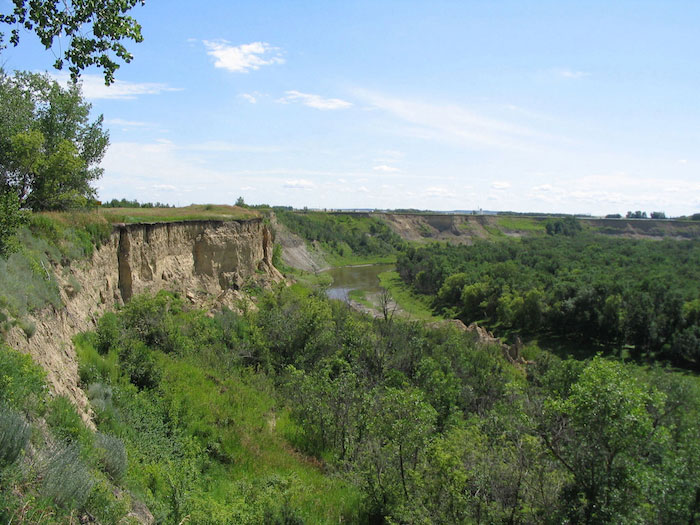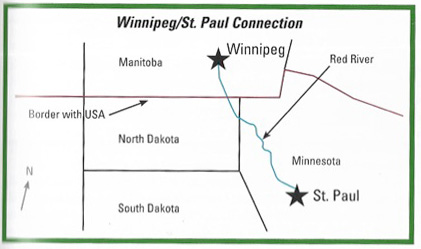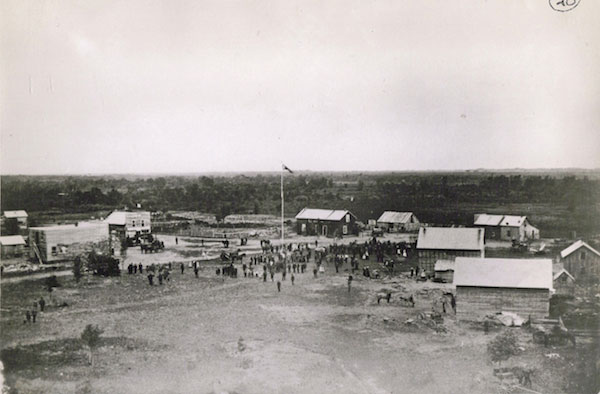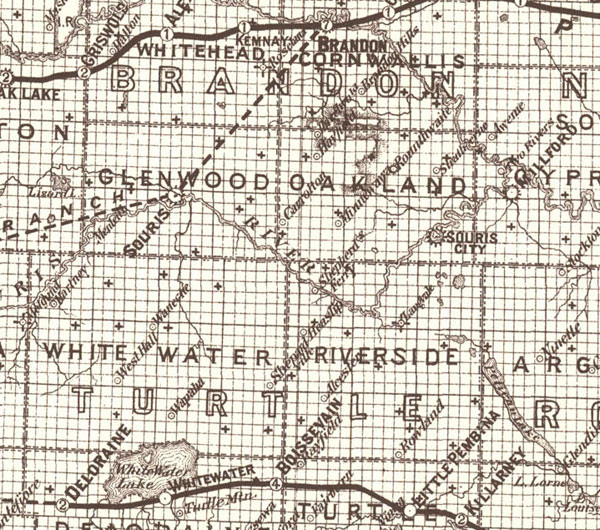

Local History Matters
IIf we want to engage students (and teachers …
and citizens) in our nation’s history we should do everything we can to
make it real, to make it relevant, to connect ourselves to the story.
That starts with acknowledging, understanding and appreciating that
interesting and important things happened here.
Textbooks and “survey” histories, by their very nature skip local
details – they are about the big picture. They try to cover all the
bases.
No wonder so many students find them boring.
They not only miss details – they sometimes get them wrong.
History without geography can really miss the point. History without
accurate local content isn’t likely to connect.
Let me offer a seemingly small example.
“The Millennium in Manitoba”, a popular summary of Manitoba history, in
attempting to describe the buffalo hunting culture of Manitoba’s First
Nations, makes the following statement:
“In Alberta, buffalo could be driven over a cliff to their deaths, but
there were no escarpments steep enough in Manitoba.” P5

The Souris River, near Wawanesa.
I’ve been to “Head Smashed in Buffalo Jump” and I’ve paddled down the
Souris River from Souris to Wawanesa. And while it is true that “Head
Smashed In” is a truly significant site, and was used on a huge scale,
we also know that, although buffalo pounds and other methods were more
commonly used on the prairies, more than a few buffalo perished on our
riverbanks as well.
As a student, I might have found that interesting, in History class it
always seemed that the interesting things happened elsewhere.
What we learned about the fur trade, explorers, steamboats, battles.
Stagecoaches, war, crime, industry, adventure – all were missing a
local connection.
And that’s where local history can step in.
Let me assure you that the examples I use, are from books that are
essentially well written and well researched. They are good books by
good historians. Even good books contain errors. Professional
historians make errors, we all make errors.
My point is that errors are more likely if we write from a distance. To
get accurate, engaging and relevant accounts of history we need to
complement the “professional” work from in texts with the “local”
information from those of us who live here.
In the excellent book, “Marie-Anne, The Extraordinary story of Louis
Riel’s Grandmother” by Maggie Siggins, the Saskatchewan based writer,
confuses a few Manitoba geographical details.
On page 76 a footnote …
A very minor error to be sure, but because I have lived and hiked along
the Pembina River and travelled extensively in southern Manitoba, I
know its course. And its headwaters are quite a bit to the west.
This next one might just be some sort mix-up of names but it doesn’t
make any sense at all.
“* The Pembina River originates north of LaRiviere, Manitoba and flows
southeast, entering the United States northeast of Langdon, North
Dakota.”
A very minor error to be sure, but because I have lived and hiked along
the Pembina River and travelled extensively in southern Manitoba, I
know its course. And its headwaters are quite a bit to the west.
This next one might just be some sort mix-up of names but it doesn’t
make any sense at all.
“…bands, known by this time as Saulteaux, were spending most of there
time at Netley Creek, near the mouth of the Red River, between Portage
La Prairie and Lake Manitoba, about fifty kilometres north of the
Forks.”
This one was also the result of some sort of mix-up with names
“…it was revealed that a much larger stash of pemmican was stored at
Fort La Souris near Turtle River, south of Pembina.”
The Turtle River is indeed south of Pembina but the La Souris Post is
nowhere near it – in fact in the opposite direction. It is indeed, as
later related, quite close to HBC’s Brandon House – quite a distance
north west of Pembina along the Assiniboine River near its confluence
with the Souris River.
Once again I know that because I’ve been there. I live near the spot.
I’ve looked at dozens of maps old and new.
Another curious example – perhaps some sort of misprint, occurred in
Fred J. Shore’s “Threads in the Sash” which contains this very poorly
conceived map…

I know he was attempting to simplify things but it gives the impression
that the Red River runs directly from St. Paul to Winnipeg, when those
of us who have travelled that way know it goes almost straight south
through Fargo. What is displayed on the map may well be a fair
depiction of the old cart trail – trading route.
In 2018 a local newspaper article celebrated the erection of a
commemorative plaque near the United Church in Wawanesa, Manitoba. That
is where, in 1896, Nellie Mooney married Wesley McClung. The writer
points out that, ”Wawanesa is not usually mentioned in books and
articles on Nellie McClung’s life many believe, due to the fact their
village when they arrived there was Millford. Wawanesa had not yet been
settled.”

True, but it is a bit more complicated than that.
As a teacher and a student of history, I knew a bit about Nellie
McClung and her role in the battle for Women’s suffrage. I had read at
least one of her works of fiction, and counted myself well informed in
general. But what I didn’t know, what my high school and university
history courses had neglected to tell me, was that she grew up just a
short distance from my home town. I had no idea that in the
numerous times that I had driven down Highway #2 in the Wawanesa area,
I passed within sight of the school yard were she got her early
education, within a few kilometres of the homestead where she grew up.
In fact I knew distant relatives of hers, (there are still quite a few
in the area) before I knew anything about her early life.
I think I would have appreciated that information. Id think that
knowing about a local concrete link to this prominent Canadian would
have made History a bit more real for me.
In that sense, geography matters. Historians can be somewhat careless
about physical details that might establish more of a sense of place to
the stories of the past.
The Encyclopedia of Manitoba (an excellent volume) lists Nellie’s
childhood home as Millbrook (p409). “The Millennium in Manitoba”
another very useful book, claims that Nellie “had little formal
education – five years of public school before her family moved west in
1884 (p95), and “Manitoba 125 tells us that her family
homesteaded in Manitou.(p122) Where did that come from? Either
someone didn’t check even the most basic of sources, or an editor
simply made a mental error. Either way it reflects a general lack of
concern, a mindset in which such details are of little consequence.
Most publications correctly state that she came to Manitoba as a child,
and avoid details by saying, “to farm on the Souris River”. It's a long
river. An August 25, 1973 article in the Brandon Sun that summarizes
her accomplishments on the occasion of a stamp being issued in her
honour, begins by missing her date of birth by six years, and ignoring
her childhood except for saying that she moved to Manitoba in 1880.
This, to me, reflects a general lack of concern about location, a
mindset in which such details are of little consequence.
A most cursory glance at one of several local histories, let alone a
reading of her own very readable memoir "A Clearing in the West", would
quickly uncover the facts that she got her public school education in
Northfield School, near the village of Wawanesa, after moving to a farm
near Millford in 1880. Manitou was where she moved to get a
teaching job, and where she lived when taking those first steps to a
career in writing.

Nellie wrote extensively about her early years on the farm, and about
the nearby village of Millford, a well-established village before
Brandon and other Westman communities were established.

In 1887, after the railway arrived and numerous
villages were started, Millford was still on the map.
To be sure those details might seem trivial – of interest only to those
local people who want to lay claim to her story. But I think those
details matter. For one thing, each of those mistaken facts cause me to
wonder what other details were fiction. Surely historical accuracy is
of value in and of itself, even if it involves events that took place
beyond the perimeter, so to speak?
We also should recognize that in trying to understand how a person
forms values, opinions, skills, and aptitudes; those childhood years
really do matter.
The people in Wawanesa, Manitoba, know exactly where Nellie McClung
lived as a child, where she attended school, where she attended the
Dominion Day Picnic in 1883.
I didn’t know.
I think that instead of bemoaning the fact that interest in History
seems to be declining, we should be examining the possibility that if
we allow for an easier connection between the somewhat abstract facts,
figures and dates, and the physical concrete places, buildings and
artifacts, we will find the people indeed do like history.
Aside from that; helping us have a better understanding of the story to
be told, and proper details about place, might also help us understand
the people. I think it is pretty well accepted that the experiences of
one’s formative years are important.
In Wawanesa where in 1896 Nellie Mooney married Wesley McClung in a
church that still stands overlooking the Souris River valley, people
are proud of the community’s link to the lady and her achievements. The
woman who became known as "Our Nell", was "Their Nell" long before she
became famous.

|
 |
|
|
|